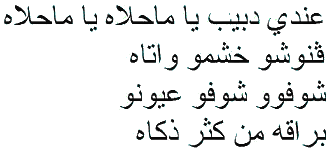Mourad Bendjennet sent us information about a new way of transliterating Arabic that has come about since the advent of computers. Here we’re talking specifically about transliterating Arabic by writing the language in the Roman alphabet to show how to pronounce it in English…
“With the introduction of computers and text messages among Arabs, they write a lot of transliterations. They noticed that many Arabic letters were written with Latin letter compounds that made reading difficult. So they decided to create a new way of writing.
Example #1 : Instead of writing ‘Kh’ like Spanish ‘j’ or German ‘ch’ in ‘Bach’, we write the number 5. Graphically speaking, it looks like the letter خ. On top of that, Arabic number 5 is pronounced Khamsa. There’s the letter خ in this number.
Example #2 : Instead of writing ‘Ha’ (strong ‘h’) like Mohamed or Halal, we write number 7. Graphically speaking, it looks like the letter ح.
Example #3 : Formerly, the letter ‘K’ would transliterate both ك and ق, while it should transliterate only the letter ك. As to the letter ق, it’s presently replaced by the number 9. Graphically speaking, 9 looks like the letter ق. To pronounce it, the “k” sound must go out from the bottom of the throat, not from the top of it.
Example #4 : Formerly, the letter ‘A’ would transliterate the letter أ while it’s pronounced rather “eh” than “ah”. So number ‘2’ was adopted because graphically speaking, it looks like the symbol on the top of the letter أ, that is to say ء.
Example #5 : Formerly, the letter ‘T’ would transliterate both ت and ط, while it should only transliterate the letter ت. As for the letter ط it’s presently replaced by number 6 because graphically speaking, it looks like the letter ط. The letter ت is pronounced ‘t’ like in ‘tea’ (without the ‘explosion’ of English ‘t’ pronunciation) and the letter ط is pronounced ‘Ta’ (i.e. curving the soft palate upwards).
Example #6 : Instead of writing ‘Aa’ to transliterate the letter ع an ‘ah’ sound going out from the bottom of the throat, we write number 3 because it graphically looks like it.
Example #7 : The letter هـ (pronounced ‘h’) is replaced by number 8 because graphically speaking, it looks like the letter هـ.
Following those principles, we can show the transliteration of a specific children’s song from Tunisia. First you’ll see it in the Arabic text, then the transliteration, followed by an English translation…

Transliteration
3andi dbeyyib ya ma7le8 ya ma7le8
Gannooshoo 5ashmoo wate8 (x2)
Shoofoo shoofoo 3yoonoo (x2)
Barra9a min koth’r thke8.
All the R’s are rolled.”
English Translation
I have a nice soft Teddy Bear
His nose looks very fine
Look, look, his eyes,
Shining with intelligence.
Many thanks to Ilyes Bekri for contributing this song and to Monique Palomares for the English translation. Thanks also to Mourad Bendjennet for help with the song and such an interesting commentary about the new way to transliterate the Arabic language.
Come visit our Arabic Children’s Song Page for links to all of our Arabic kids songs.
You can also read this post about Arabic transliteration in French or Spanish.
Mama Lisa
This article was posted on Friday, February 13th, 2009 at 3:50 pm and is filed under Arabic, Countries & Cultures, Egypt, English, Holidays Around the World, Languages, Mama Lisa, Morocco, Tunisia. You can follow any responses to this entry through the RSS 2.0 feed. You can skip to the end and leave a response. Pinging is currently not allowed.

























February 20th, 2010 at 3:18 pm
I’m interested in learning Arabic. I would like more info or site to translate tranlitertial Arabic to english.
Thanks,
Monica
June 16th, 2015 at 1:15 am
Can you tell me what is being chanted to this little boy? I am guessing it’s in Arabic, and I thought it might be a nursery rhyme, but I have no way of searching for it successfully.
https://www.youtube.com/watch?v=tfHRNaN-IpM